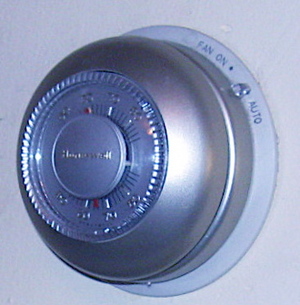So, need a new thermostat for your home’s heating and cooling system or just want to upgrade to a programmable thermostat? No problem, you can do it.
Step 1. Turn off the juice. Every furnace, air handler and boiler supply low voltage power to your thermostat. You must shut off the power to your system before proceeding any further with replacing your t-stat. Simply go to your furnace or boiler and search for electrical lines coming into the unit. Almost all systems use a SSU or SSY switch which is a metal on and off switch that also has a fuse holder in it. Turn it to off and then test t-stat to verify that the electricity is off by cycling the system to see what happens.
Step 2. Remove old thermostat. Simple right? Yes but also the most important step to be sure that you follow the direction carefully. Make sure that you write down which terminal that each color of wire is connected to. The terminals that you will encounter will be marked with letters representing possible wiring colors. Just make very sure that you know which colored wire came off which lettered terminal. Not all thermostat wiring is going to be the colors that match correctly. Secure the wires that are hanging from the wall to keep them from being pushed into wall cavity during installation.
Step 3. Attach new thermostat base to the wall following manufacturer’s directions. Digital thermostats do not have to be perfectly level for performance but mechanical or those containing mercury switching bulbs do. The best way to do this is to use a small level like a plumbers torpedo level or a small pocket level. On Honeywell T-87 thermostats there are two posts on the top of the switching base that are designed to lay a small level across for leveling purposes. I mention the T-87 because it is the most popular mechanical model.
Step 4. Connect wiring. This is where step 2 and following directions can save a lot of headaches and probably a visit from the repairman. Take your time and be sure that no bare ends of the wires are touching each other or might touch when you put the cover unless you like heating and cooling running at the same time. And by the way, heating always wins out over cooling when they are competing against each other.
Step 5 Making a few tweaks. On digital thermostats most models have a gas/electric selector switch. This refers to the kind of heating system you have in your home. You may be a bit confused here since both types have electricity coming into them for operation. If you have a gas appliance you will have a vent going into your chimney or exiting some other way from your house. If you have electric you will have only wires coming and no venting going out. Also, mechanical thermostats have a small sliding dial that is under their covers that is called a heat anticipator. It is important to get it set correctly or your unit may not cycle correctly. Try to match it to the one that you removed or some furnaces have that number written on the gas valve in the burner compartment.
Tools needed: Small level, wire strippers, small screw drivers, and possibly drill with 1/8th inch bit for using anchors in plaster and lathe application.







